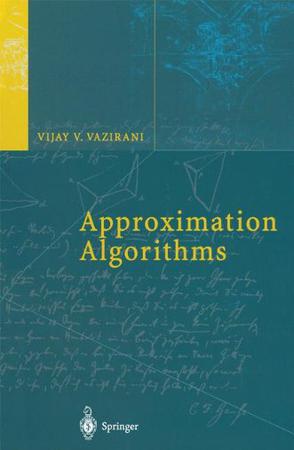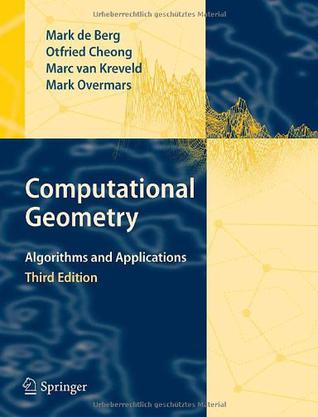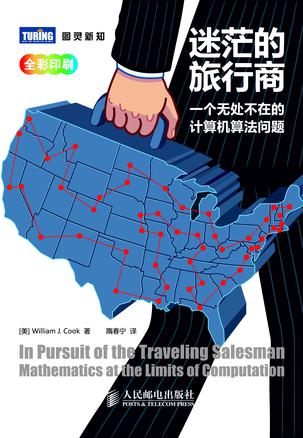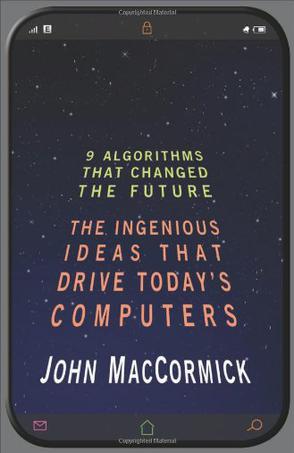-

Genetic Algorithms in Search, Optimization, and Machine Learning
This book brings together - in an informal and tutorial fashion - the computer techniques, mathematical tools, and research results that will enable both students and practitioners to apply genetic algorithms to problems in many fields. Major concepts are illustrated with running examples, and major algorithms are illustrated by Pascal computer programs. No prior knowledge of GAs or genetics is assumed, and only a minimum of computer programming and mathematics background is required. 0201157675B07092001 -

Approximation Algorithms
Covering the basic techniques used in the latest research work, the author consolidates progress made so far, including some very recent and promising results, and conveys the beauty and excitement of work in the field. He gives clear, lucid explanations of key results and ideas, with intuitive proofs, and provides critical examples and numerous illustrations to help elucidate the algorithms. Many of the results presented have been simplified and new insights provided. Of interest to theoretical computer scientists, operations researchers, and discrete mathematicians. -

Computational Geometry
This well-accepted introduction to computational geometry is a textbook for high-level undergraduate and low-level graduate courses. The focus is on algorithms and hence the book is well suited for students in computer science and engineering. Motivation is provided from the application areas: all solutions and techniques from computational geometry are related to particular applications in robotics, graphics, CAD/CAM, and geographic information systems. For students this motivation will be especially welcome. Modern insights in computational geometry are used to provide solutions that are both efficient and easy to understand and implement. All the basic techniques and topics from computational geometry, as well as several more advanced topics, are covered. The book is largely self-contained and can be used for self-study by anyone with a basic background in algorithms. In this third edition, besides revisions to the second edition, new sections discussing Voronoi diagrams of line segments, farthest-point Voronoi diagrams, and realistic input models have been added. -

迷茫的旅行商
假设一名旅行商打算拜访一张城市列表中的所有城市,每座城市只去一次,最后回到出发地。要怎么走才能让路线最短呢?这就是旅行商问题,乍一听很简单,在应用数学界却是一道研究极其热烈的难题,时至今日仍无人能解。本书中,William J. Cook将带领读者踏上一场数学之旅,跟随旅行商的脚步,从19世纪初爱尔兰数学家W. R. Hamilton最初定义该问题开始,一路奔向当今最前沿、最顶尖的解题尝试。 作者追根溯源,回顾了旅行商问题的历史,探索了它的种种重要应用,比如基因组测序、设计计算机处理器、整理音乐乃至搜寻行星等。他分析了计算机如何抗衡规模宏大的旅行商问题,探讨了人类如何在不借助计算机的情况下独立破解难题。他一路穿越神经科学、心理学与艺术的王国,向读者下了战书:试试解决这道难题吧!旅行商问题价值百万美元——这是克雷数学研究所的悬赏金额,只要解出该题或证明该题不可解,就能得到这笔奖金。 《迷茫的旅行商》介绍了人类对于复杂性本质的理解与局限,将激励读者从此踏上求解这道迷人难题的漫漫征程。 -

Algorithms to Live By
A fascinating exploration of how insights from computer algorithms can be applied to our everyday lives, helping to solve common decision-making problems and illuminate the workings of the human mind All our lives are constrained by limited space and time, limits that give rise to a particular set of problems. What should we do, or leave undone, in a day or a lifetime? How much messiness should we accept? What balance of new activities and familiar favorites is the most fulfilling? These may seem like uniquely human quandaries, but they are not: computers, too, face the same constraints, so computer scientists have been grappling with their version of such issues for decades. And the solutions they've found have much to teach us. In a dazzlingly interdisciplinary work, acclaimed author Brian Christian and cognitive scientist Tom Griffiths show how the algorithms used by computers can also untangle very human questions. They explain how to have better hunches and when to leave things to chance, how to deal with overwhelming choices and how best to connect with others. From finding a spouse to finding a parking spot, from organizing one's inbox to understanding the workings of memory, Algorithms to Live By transforms the wisdom of computer science into strategies for human living. -

Nine Algorithms That Changed the Future
Every day, we use our computers to perform remarkable feats. A simple web search picks out a handful of relevant needles from the world's biggest haystack: the billions of pages on the World Wide Web. Uploading a photo to Facebook transmits millions of pieces of information over numerous error-prone network links, yet somehow a perfect copy of the photo arrives intact. Without even knowing it, we use public-key cryptography to transmit secret information like credit card numbers; and, we use digital signatures to verify the identity of the websites we visit. How do our computers perform these tasks with such ease? This is the first book to answer that question in language anyone can understand, revealing the extraordinary ideas that power our PCs, laptops, and smartphones. Using vivid examples, John MacCormick explains the fundamental "tricks" behind nine types of computer algorithms, including artificial intelligence (where we learn about the "nearest neighbor trick" and "twenty questions trick"), Google's famous PageRank algorithm (which uses the "random surfer trick"), data compression, error correction, and much more. These revolutionary algorithms have changed our world: this book unlocks their secrets, and lays bare the incredible ideas that our computers use every day.